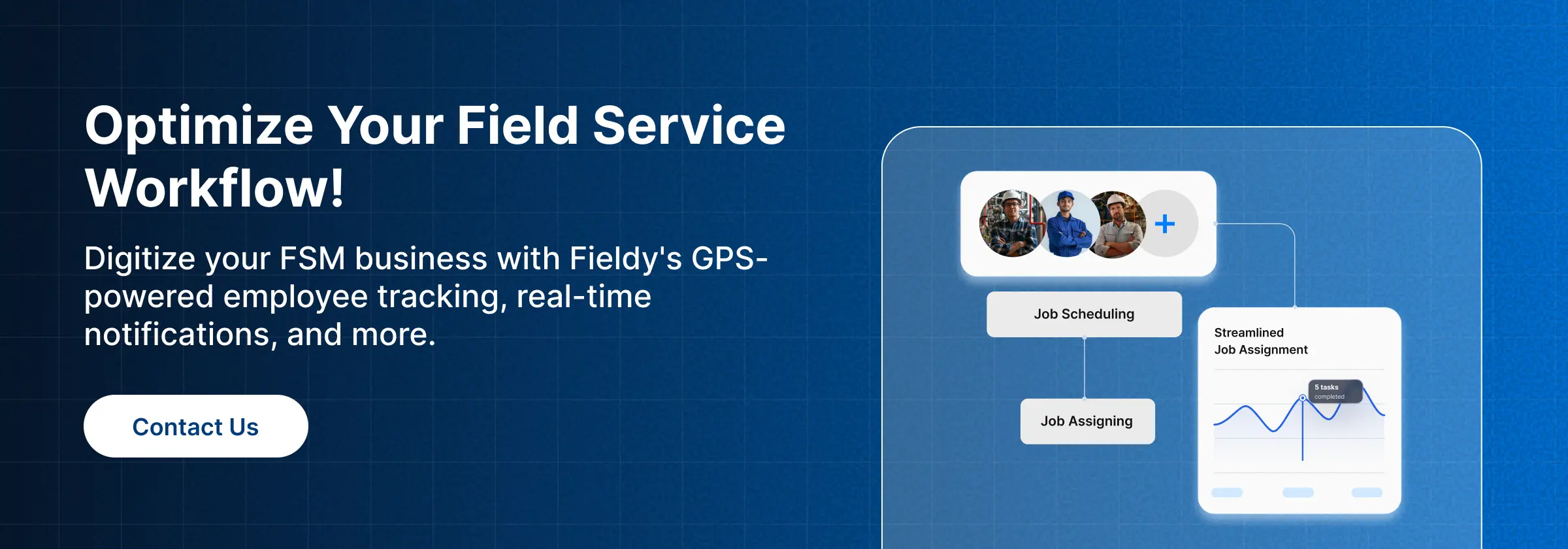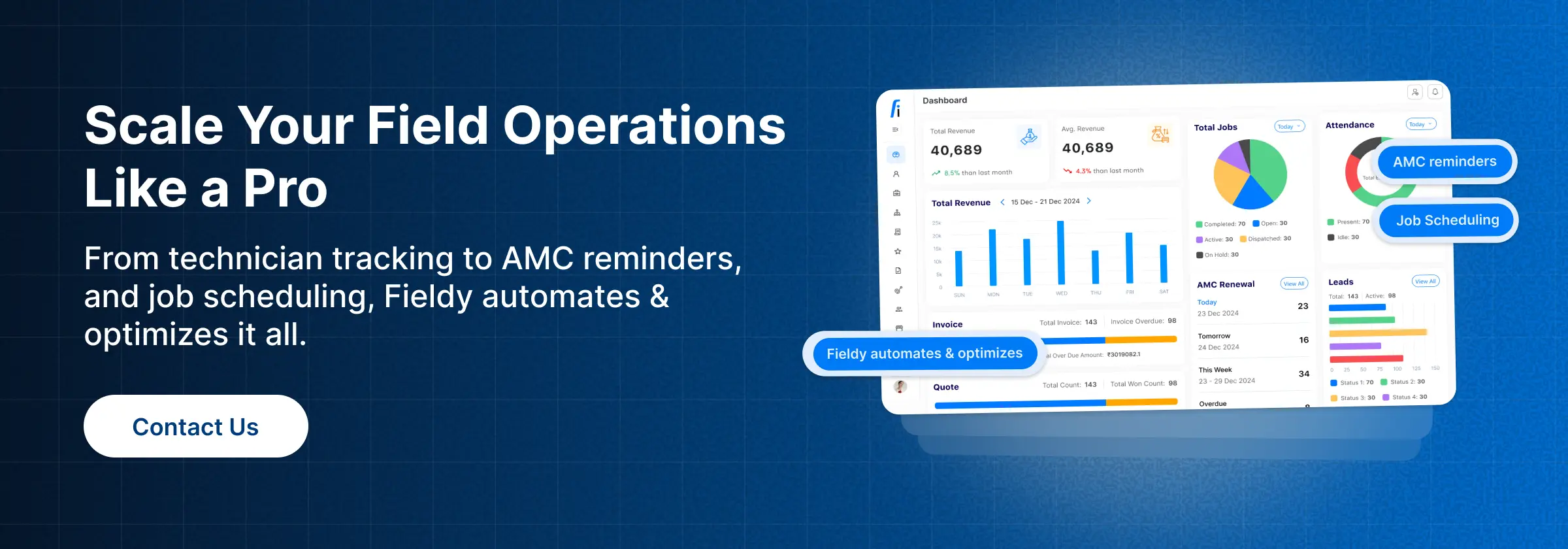Introduction 💹
If one were to name the most obvious indicators of prosperity or decline of an FSM business, revenue growth could be on top of that list. Businesses now need to track growth not only for the purpose of measuring their achievements but also for planning their futures in an increasingly competitive landscape marked with rising operation costs and sky-high customer expectations. From managing an HVAC company to pest control or a huge telecom company, knowing how to compute revenue growth can help in financial planning, optimizing workforce efficiency, and customer satisfaction.
This measure has arguably become most important in 2025, for even the FSM sector is undergoing fast expansion. Recent studies on the FSM market forecast it to have a global valuation of $5–$5.6 billion by 2025, with an 11.4%–15.2% CAGR simultaneously. Businesses that can effectively track and seek to improve revenue growth thus gain a competitive edge.
This blog will cover revenue growth within the FSM, how to work it out, and factors within your operations that could be affecting it.
What is Revenue Growth in FSM? 📊
Revenue growth depicts the percentage increase in revenue over a specified period of time, usually from month to month or year to year. From an FSM perspective, revenue growth signifies much more than sales volume; it measures process efficiencies in service delivery, customer retention, and profitability in all areas.
Revenue Growth (%) =
Current Period Revenue – Previous Period Revenue
Previous Period Revenue
× 100
Example: If an FSM company earned $1M in 2024 and $1.12M in 2025:
1.12M – 1M
1M
× 100 = 12%
This simple formula also applies when learning how to calculate annual revenue growth, which helps track longer-term trends and identify whether growth is sustainable or seasonal.
In the broader FSM sector, the numbers highlight this principle: the market is projected to grow from $4.55B in 2024 to $5.12B in 2025, which equals a 12.5% growth rate. These figures show how consistent tracking can reveal both opportunities and challenges for businesses.
Companies relying on field service management software often find it easier to centralize revenue data and run such calculations in real time, reducing the chances of misreporting.
Factors That Contribute to Revenue Growth in FSM 🚀
1. Lead Management 🔗
Leads are the lifeblood of any service business. Proper lead capture-tracking-nurturing directly affects conversion rates, which drive revenue. Studies have shown that companies employing automated lead management software can gain up to a 15-20% uplift in conversion rate.
Missed leads for an FSM firm usually translate to missed revenue opportunities. Specifying lead performance in terms of revenue growth metrics enables managers to define bottlenecks and realign strategies accordingly, propping up cases of field service lead generation management software.
2. Quoting & Estimation Software 📝
Accurate and timely quotes not only build customer trust but also prevent revenue leakage from underpricing. Inconsistent manual quotes can lead to lost opportunities or undervalued jobs, both of which affect growth.
FSM businesses that adopted automated quoting systems have reported higher win rates on proposals and better revenue consistency. A telecom firm, for example, boosted technician utilization by 16% after integrating quoting with scheduling tools, which directly translated to increased service revenue.
This is where field service quoting software plays a crucial role; it ensures estimates are fast, consistent, and profitable.
3. Quick and Easy Invoicing 💳
Cash flow is the backbone of revenue growth. If invoices are delayed or disputed, businesses suffer. Automated invoicing not only reduces errors but also accelerates payments, improving cash flow cycles.
According to industry reports, companies using automated invoicing systems cut payment delays by 30–40%, while customers reported higher trust due to transparent billing. FSM companies leveraging field service invoicing software ensure smoother operations while safeguarding revenue growth. ⬇️
4. Timesheet Management ⏱️
One of the most overlooked aspects of revenue growth is workforce efficiency. If technician hours aren’t tracked accurately, businesses risk underbilling or overpaying.
By monitoring timesheets closely, FSM managers gain insights into utilization, productivity, and profitability. For example, a manufacturing firm using FSM-based time tracking reduced downtime and recorded a 14.6% CAGR in service revenue.
This is why integrating field service time tracking software into operations is critical, it ensures every hour billed aligns with delivered value.
5. Online Payments 🌐
Customer convenience is now a major growth driver. Businesses that offer multiple online payment options, credit card, UPI, wallet, or bank transfer, collect revenue faster and reduce outstanding receivables.
Reports show that enabling online payments in FSM solutions cuts payment cycles by nearly 50%, giving businesses quicker access to working capital. Platforms that integrate field service management software for online payments allow customers to settle invoices instantly, creating a frictionless payment experience.
How to Calculate Revenue Growth Step by Step 🧮
Tracking revenue growth requires structured data and consistent monitoring. Here’s how FSM businesses can do it:
- 📊 Gather revenue data from your FSM platform by month, quarter, or year to establish a clear baseline. Consistency ensures accuracy when comparing performance over time.
- ➗ Apply the revenue growth formula to measure increases or declines across these periods. This helps track both short-term wins and long-term financial stability.
- 🏗️ Segment revenue by service lines such as HVAC, pest control, or home improvement. Doing so highlights which areas fuel the most growth and which require strategic improvements.
- 📈 Leverage FSM analytics dashboards to uncover actionable insights. For example, data might reveal that invoicing automation boosts revenue more effectively than simply generating new leads.
Companies using employee productivity tracking software often gain deeper insights, since technician output and utilization directly link to revenue numbers.
Best Practices to Boost Revenue Growth with FSM Software 💡
- 🤖 Automate core processes like quoting, invoicing, and payments to eliminate bottlenecks, accelerate cash flow, reduce manual errors, and free up staff to focus on higher-value tasks.
- 👷 Track technician utilization closely to improve workforce efficiency, ensuring the right resources are deployed to the right jobs.
- 🔮 Use predictive analytics to anticipate revenue trends more accurately, identify growth opportunities, and guide long-term strategic planning for your FSM business.
- 📄 Upsell AMC contracts to secure recurring revenue streams. This not only boosts financial stability but also strengthens long-term customer relationships by ensuring ongoing service commitments and repeat business.
A growing number of businesses use AMC management software to offer preventive maintenance packages, which not only stabilize revenue but also improve long-term customer retention.
Industry Statistics, Insights & Case Studies (2025 Highlights) 🌎
- Global FSM market valuation: $5.0B–$5.6B in 2025.
- Projected CAGR (2025–2030): 11.4%–15.2%.
- Telecom industry share: nearly 32% of total FSM revenue in 2025.
- On-premises deployment: still dominant at 48% market share.
- India’s FSM CAGR (2025–2035): expected at 19.35%, reflecting strong regional adoption.
Industry Insights: Growth is driven by cloud adoption, AI-based predictive maintenance, mobile workforce optimization, and customer-centric service models.
Case Studies:
- AI-enhanced scheduling in FSM platforms boosted revenue by 15–20% through predictive maintenance.
- Telecom companies saw 16% higher technician utilization with FSM solutions.
Manufacturing firms reduced downtime and achieved a 14.6% CAGR in service revenue after adopting FSM tools.
Conclusion ✅
Understanding how to calculate revenue growth is essential for FSM businesses aiming to thrive in 2025 and beyond. By applying the annual revenue growth formula consistently and linking it with operational factors like lead management, invoicing, workforce productivity, etc., via revenue growth field service software integration, companies can uncover powerful insights.
The FSM sector is already showing double-digit growth worldwide, and businesses that harness software tools for automation, analytics, and customer experience are positioning themselves at the forefront.
Revenue growth, therefore, is not just about selling more; it’s about optimizing every step of the service journey to ensure profitability and long-term sustainability. ⬇️


![How to Calculate Revenue Growth in Terms of FSM – [A 2025 Masterclass]](https://blog-admin.getfieldy.com/wp-content/uploads/2025/09/How-to-Calculate-Revenue-Growth-in-FSM.webp)

